Improve your reflexes with these coordination-boosting drills: simple reaction drills for basic responses, choice reaction exercises for decision-making, wall ball toss for unpredictable scenarios, partner rebound challenges, multi-directional movement drills, call-and-response exercises, color-coded training, rhythm-based activities, single-leg challenges for proprioception, and aerial catch techniques. Track your progress through timed assessments and video analysis. The following techniques will transform your athletic performance through neural adaptations and enhanced motor skills.
Reactionary Bounce Patterns for Lightning-Fast Responses
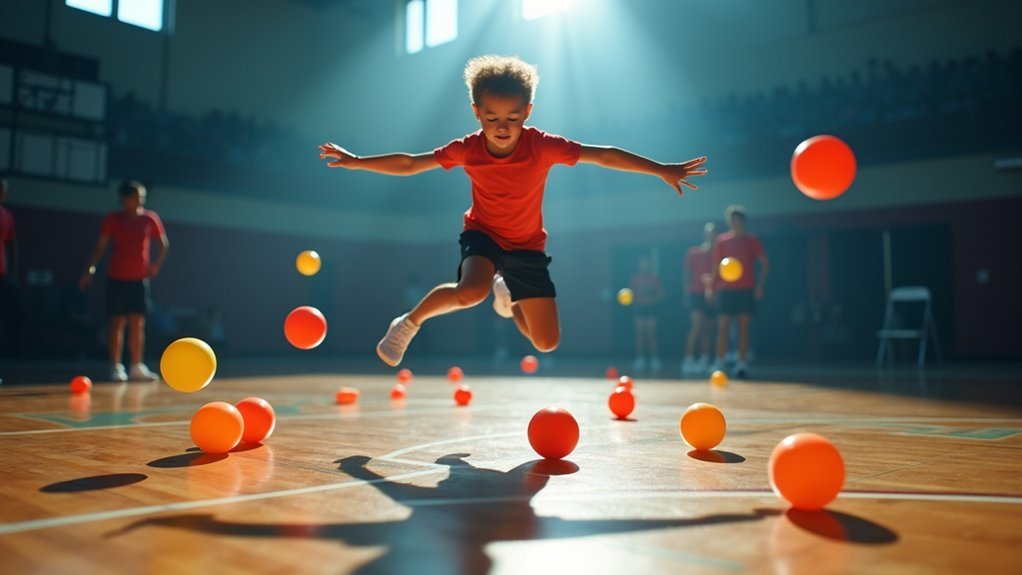
When athletes need to gain an edge in their performance, reactionary bounce patterns offer a strategic training approach that can transform reflexes.
These specialized drills enhance your ability to respond quickly to visual and auditory cues, dramatically improving reaction time and coordination.
Start with the Drop and Catch drill, progressively increasing difficulty by dropping the reaction ball from higher positions.
Then advance to Tossing the Ball Against the Wall, which simulates unpredictable game scenarios.
For advanced training, try the Pyramid Bounce Drill to manage multiple balls at varying bounce rates.
Don’t overlook Seated Dribbling Techniques, which develop control with both hands simultaneously.
This translates directly to improved reaction speed when you’re facing dynamic competitive situations that demand split-second decisions.
Ball Toss Drills on Mini Trampolines
Taking reaction training to new heights, ball toss drills on mini trampolines introduce an element of instability that revolutionizes traditional hand-eye coordination exercises.
You’ll find your reflexes sharpening as you adapt to the unpredictable bounce while tracking and catching balls from various angles.
- Vary the height and angle of tosses to simulate game-like scenarios, forcing your brain to recalibrate coordination patterns with each repetition.
- Introduce multiple balls to enhance multitasking abilities and accelerate your visual processing speed.
- Progress gradually from stationary catches to more dynamic movements while maintaining rhythm on the trampoline.
With consistent practice, you’ll notice significant improvements in your hand-eye coordination that transfer directly to your sport of choice.
Regular practice creates neural adaptations that enhance coordination skills, making real-time game performance more fluid and intuitive.
The combination of balance challenges and precision catching creates neural adaptations that traditional stationary drills simply can’t match.
Partner Rebound Challenges for Visual Coordination
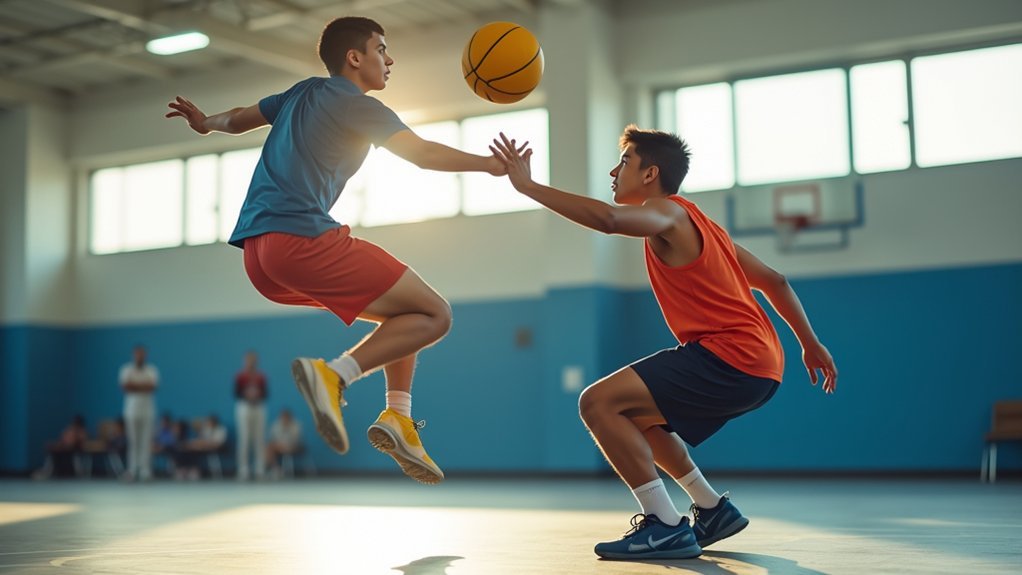
Partner Wall Fast Passes challenge you to rapidly exchange throws against a wall, improving your visual tracking and hand speed.
In Tennis Ball Bounce Relay, you’ll coordinate with your partner to catch rebounds after specific bounce patterns, enhancing your depth perception and timing.
Surprise Direction Tosses force you to adapt instantly as your partner randomly varies the trajectory and speed of throws, sharpening your anticipatory skills and peripheral vision.
Partner Wall Fast Passes
As athletes seek to improve their reaction time, the Partner Wall Fast Passes drill offers an excellent opportunity to enhance visual tracking and hand-eye coordination simultaneously.
Position yourself and a partner at varying distances from a wall, taking turns throwing a ball against it while the other catches the rebound. You’ll notice your reflexes sharpening as you adjust to different angles and speeds.
- Try incorporating a reaction ball to introduce unpredictable bounces that force quicker adaptations
- Maintain an athletic stance with bent knees and active feet to position yourself efficiently
- Gradually decrease recovery time between catches to build decision-making under pressure
Tennis Ball Bounce Relay
Reactions in milliseconds can determine success in competitive sports. The Tennis Ball Bounce Relay sharpens these split-second responses through partner-based coordination challenges.
Stand several meters from your partner and bounce a tennis ball toward them, aiming for one ground contact before they catch it. The tennis ball’s unpredictable rebounds force quick adaptations, simulating game-time reactions.
Increase difficulty by widening the distance between partners or adding movement patterns like side shuffles or backward steps before catches. Time your relay to create friendly competition—try completing a specific number of successful catches as quickly as possible.
This drill strengthens visual tracking while improving your hand-eye coordination under pressure, translating directly to enhanced performance when split-second decisions matter most.
Surprise Direction Tosses
While predictable drills build foundational skills, the Surprise Direction Tosses challenge your visual processing at an advanced level.
Working with a partner who randomly tosses a ball in unexpected directions forces you to react quickly and catch the ball, enhancing your coordination and reaction speed.
- Increase difficulty by varying the toss speed and height, pushing your adaptability in different catching scenarios
- Add movement requirements like shuffling or sprinting to the landing spot to develop agility alongside coordination
- Practice consistently to see noticeable improvements in your hand-eye coordination during competitive situations
This drill keeps you alert and improves your ability to process visual stimuli rapidly.
As you master the unpredictable nature of these tosses, you’ll develop lightning-fast reactions that translate directly to game situations.
Multi-Directional Movement Drills on Rebounders
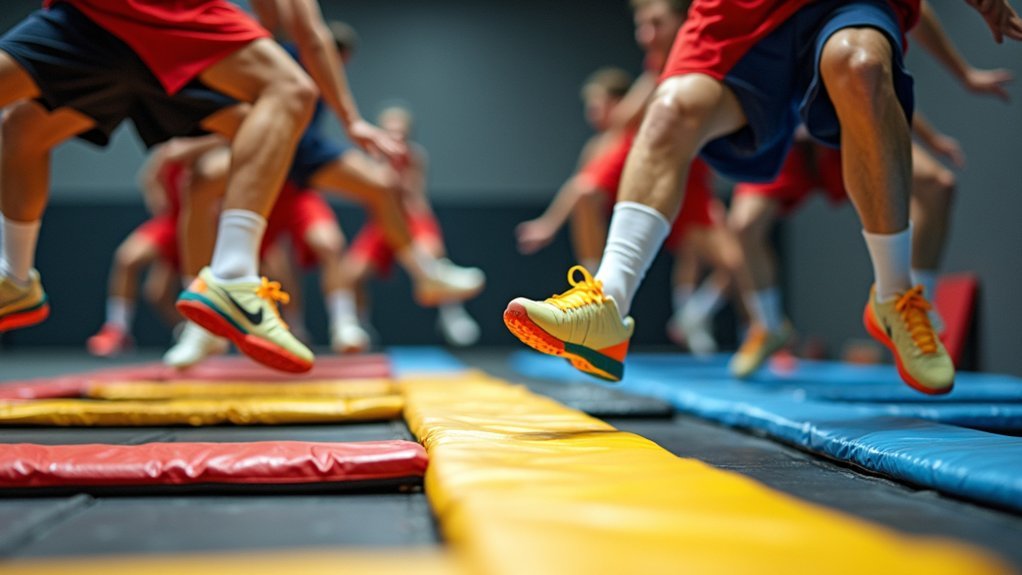
When athletes need to elevate their agility training, rebounders offer an exceptional platform for developing lightning-fast reactions.
You’ll find these drills to improve your footwork and coordination dramatically as you respond to unpredictable ball trajectories.
Incorporate various movements like shuffles, lateral slides, and quick hops while working with the rebounder.
This all-encompassing approach trains different muscle groups simultaneously and enhances your ability to change direction instantly.
The rebounder’s unique properties create game-like scenarios that demand heightened reflexes and adaptability.
Call-and-Response Rebounder Exercises
To truly elevate your reaction capabilities, call-and-response rebounder exercises combine verbal cues with physical reactions, creating a dynamic training environment that mirrors real game situations.
You’ll improve reaction times considerably as you catch or redirect rebounding balls while processing verbal commands from your coach.
- Customize difficulty by adjusting rebound angles, speeds, and distances to match your current skill level
- Challenge yourself with multiple balls or unpredictable command rhythms to simulate the chaos of competitive play
- Integrate both visual and auditory stimuli to develop split-second decision-making abilities
These exercises are particularly effective because they train your brain and body to respond under pressure.
Color-Coded Reaction Training on Mini Trampolines
Color-coded reaction training transforms your mini trampoline workouts with strategically placed visual markers that challenge your brain-body connection.
You’ll enhance your ability to make split-second decisions as you react to different colored zones, forcing rapid direction changes while maintaining stability.
Your balance under pressure improves markedly as you process visual information and execute precise movements simultaneously, preparing you for real-game scenarios where quick reactions matter most.
Multicolored Visual Cues
As athletes seek to sharpen their reflexes, multicolored visual cue training on mini trampolines offers a dynamic solution for developing lightning-fast responses.
When you incorporate different colored markers into your trampoline drills, you’re challenging your brain to process multiple stimuli simultaneously—mimicking the unpredictable nature of competitive environments.
- Adjust the color-change speed to progressively challenge your cognitive processing as your skills improve
- Incorporate four or more colors to simulate complex game situations requiring split-second decisions
- Combine directional movements with the multicolored visual cues to enhance spatial awareness
You’ll notice improvements in your decision-making under pressure as you consistently practice these drills.
The cognitive-physical connection strengthens with each session, ultimately translating to quicker reactions when it matters most during competition.
Rapid Direction Changes
Building on the multicolored visual cue foundation, rapid direction changes represent the next level in reflex development on mini trampolines.
You’ll enhance your coordination by responding quickly to colored markers or lights while maintaining body control during dynamic movements.
When you practice jumping in specific directions based on color cues, you’re training your brain to process visual stimuli faster and execute precise movements simultaneously.
This integration of multiple sensory inputs develops quicker reflexes that transfer directly to competitive situations.
The mini trampoline’s low-impact surface allows you to perform high-intensity direction change drills safely, preventing the joint strain associated with traditional agility training.
Consistent practice with these color-coded reaction drills will measurably improve your reaction time and coordination—critical skills for athletes who need to change direction instantly during competition.
Balance Under Pressure
While maintaining balance on a stable surface challenges your stability, mastering equilibrium on a mini trampoline under rapidly changing color-coded instructions takes your reflexes to an elite level.
You’ll quickly improve your reaction time as you respond to different colored markers that signal specific movements or landings.
- Designate red markers for immediate stops, blue for directional changes, and green for explosive jumps to simulate unpredictable game situations.
- Practice 2-3 times weekly for 15 minutes to greatly enhance your proprioception and balance under pressure.
- Gradually increase difficulty by reducing the time between color cues or combining multiple instructions.
This dynamic training strengthens your core stability while teaching your body to maintain balance under pressure, translating directly to improved sports performance when split-second decisions matter most.
Peripheral Vision Enhancement Through Rebound Work
Everyone knows the feeling of being caught off guard by something just outside their line of sight. That’s where peripheral vision enhancement becomes essential for athletes seeking competitive advantages.
Incorporate rebound work with reaction balls to transform your spatial awareness. When you catch these unpredictably bouncing objects, you’re training your eyes to track motion across your entire visual field.
Try catching balls thrown from various angles to strengthen your ability to detect and respond to peripheral stimuli.
While maintaining focus on a primary target, practice monitoring movements in your peripheral vision. This dual-attention approach dramatically improves coordination and reflexes.
With consistent practice, you’ll develop sharper reactions to unexpected visual cues, translating directly to better performance under game conditions where split-second decisions matter most.
Rhythm and Timing Drills for Enhanced Neural Processing
You’ll notice remarkable improvements in reaction speed when you incorporate neural rhythm adaptations into your training regimen.
By practicing syncopated movement patterns that challenge your timing, you’re actually rewiring your brain to process information more efficiently.
These exercises create stronger neural pathways that allow you to anticipate and respond to game situations with precision rather than simply reacting after they occur.
Neural Rhythm Adaptations
As athletes seek to gain competitive advantages, neural rhythm training has emerged as a powerful tool for enhancing reaction speed and coordination. Your brain’s ability to process sensory information quickly directly impacts your performance in dynamic sports environments.
Through consistent practice of rhythm and timing drills, you’ll strengthen neural pathways responsible for motor control and reaction time.
- Incorporate auditory cues like metronomes or music to synchronize your movements and improve timing precision
- Practice simple rhythm drills such as clapping or foot-tapping exercises to develop faster cognitive processing speeds
- Implement progressive challenges by varying tempos and patterns to continuously adapt your neural rhythm responses
These neural rhythm adaptations aren’t just training exercises—they’re rewiring your brain for quicker responses.
Athletes who commit to regular rhythm training consistently demonstrate superior agility and reaction times in competitive situations.
Syncopated Movement Patterns
Several elite athletes attribute their lightning-fast reflexes to mastering syncopated movement patterns. By integrating rhythmic variations into your training regimen, you’ll enhance neural processing and improve coordination when quick reactions matter most.
Try incorporating a metronome or music during drills to develop superior timing sense. This practice strengthens your ability to anticipate and respond to unpredictable stimuli on the field. You’ll notice improved muscle memory, allowing you to execute complex movements efficiently under pressure.
Challenge yourself by adding unexpected pauses and rhythm changes to simulate game scenarios. These variations force your brain to adapt rapidly, creating new neural pathways that support faster decision-making.
Research confirms that syncopated training activates different cognitive functions than standard drills, giving you a competitive edge when split-second reactions count.
Aerial Catch Techniques While Maintaining Balance
The art of aerial catching combines precise timing with exceptional balance control. You’ll need to extend your arms upward while maintaining core stability to successfully execute these catches.
Try practicing with a reaction ball, which bounces unpredictably and forces you to adjust your positioning quickly, enhancing your reflexes and hand-eye coordination.
A reaction ball’s erratic bounces become your greatest training ally, demanding rapid positioning adjustments that sharpen reflexes instantly.
- Challenge yourself by performing catches on one leg or unstable surfaces to develop superior balance.
- Vary the height and angle of throws to improve your adaptability and spatial awareness.
- Incorporate jumping or sidestepping before catches to simulate game-like situations.
To master aerial catch techniques, gradually increase difficulty by combining dynamic movements with balance challenges. Your body will learn to make split-second adjustments while maintaining stability, considerably improving your overall coordination and performance.
Single-Leg Reaction Challenges for Proprioceptive Development
While aerial catch training focuses on full-body balance during upward movements, single-leg reaction challenges narrow this focus to heighten your proprioceptive development.
These drills force you to maintain stability while responding to various stimuli, greatly improving your coordination and reducing injury risk.
Begin with static single-leg holds, then progress to dynamic movements like reaching or controlled hops. Incorporate visual cues—colored lights or hand signals—to add complexity and train your brain to react quickly while balancing.
For advanced progression, introduce unstable surfaces such as balance boards to intensify the neuromuscular demand.
You’ll notice improvements in your stability and reaction time as these adaptations occur, particularly beneficial if you participate in high-impact sports where split-second balance adjustments can prevent injuries.
Frequently Asked Questions
How to Improve Coordination and Reaction Time?
You’ll improve coordination and reaction time by practicing quick-response drills, reacting to visual cues, engaging in lateral movements, and catching exercises. Warm up with rhythmic activities to prepare for complex reactions.
What Exercises Improve Reaction Time?
You’ll improve reaction time with Ball Drops Drill catching racquetballs, Shuffle Reaction Ball Drill for lateral movement, and wall tosses for unpredictable responses. Drop and Catch exercises also refine your reflexes progressively.
What Training Method Is Best for Reaction Time?
You’ll improve reaction time most effectively with drills that combine auditory and visual cues while simulating real-game scenarios. Challenge yourself with unpredictable stimuli that force quick directional changes and decision-making under pressure.
What Are Reaction Time Drills?
Reaction time drills are exercises you’ll perform to improve your ability to quickly respond to stimuli. They’ll help you develop faster reflexes and better coordination through repetitive practice with visual or auditory cues.
In Summary
You’ve now got a complete toolkit to transform your reaction times and coordination skills. Incorporate these rebound-focused drills into your regular training to see remarkable improvements. What you’ll notice isn’t just faster responses but better overall athletic performance. Remember, consistency is key—practice these drills 2-3 times weekly. Your brain and body will thank you as neural pathways strengthen and your coordination becomes second nature.

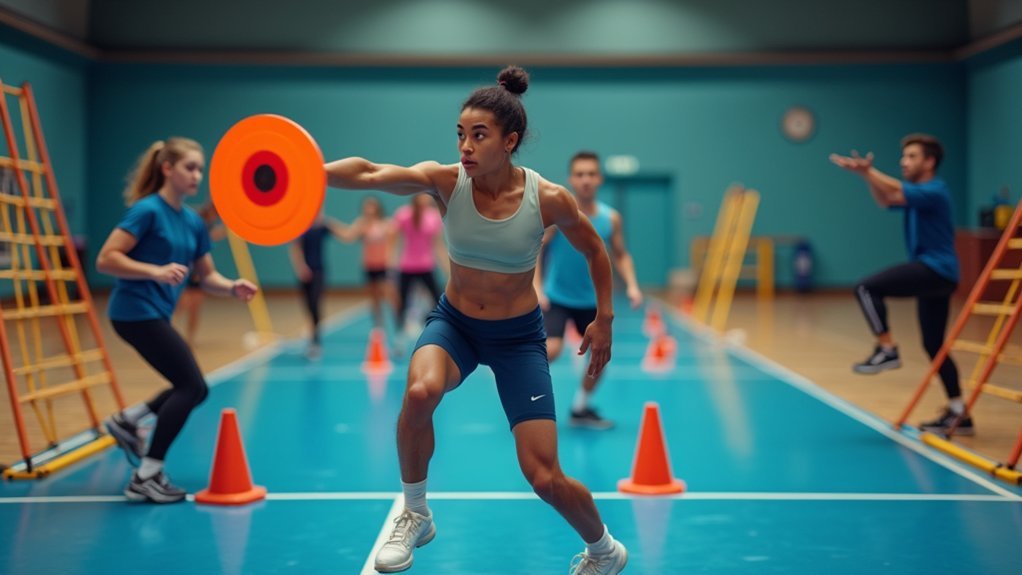

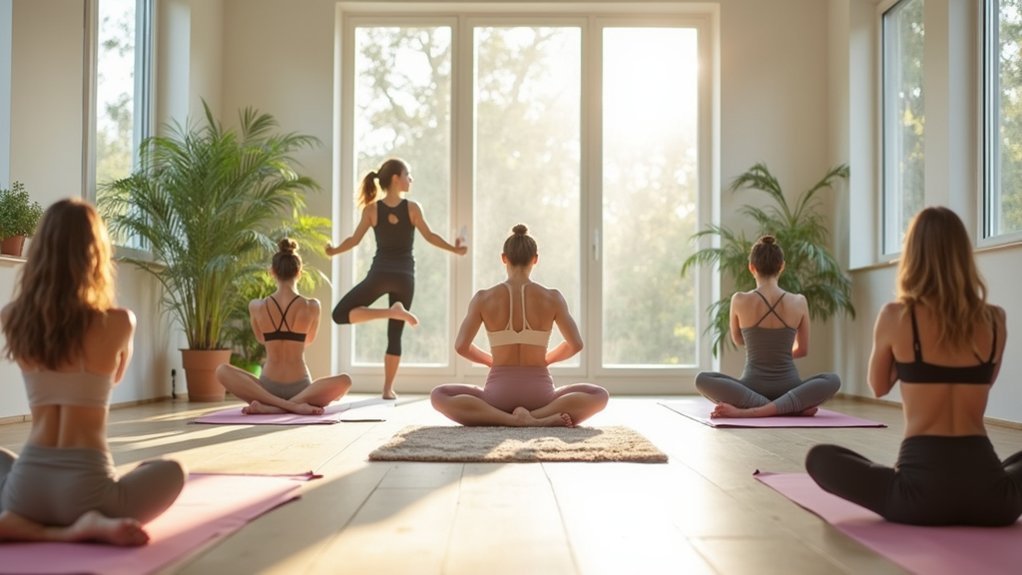

Leave a Reply